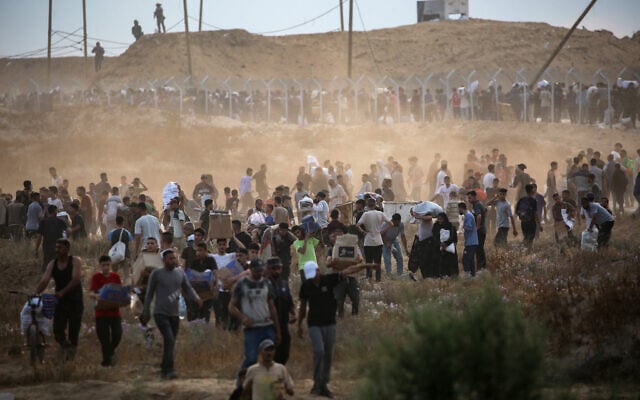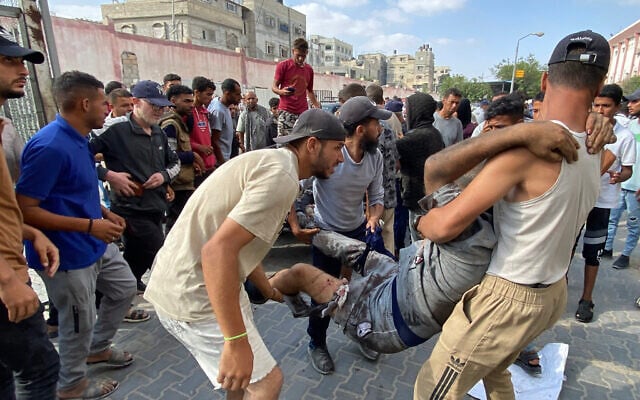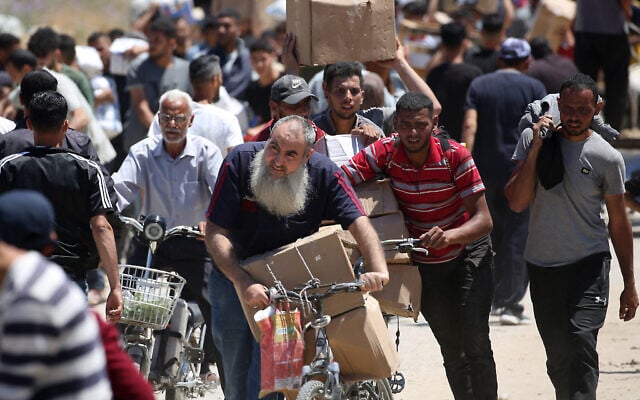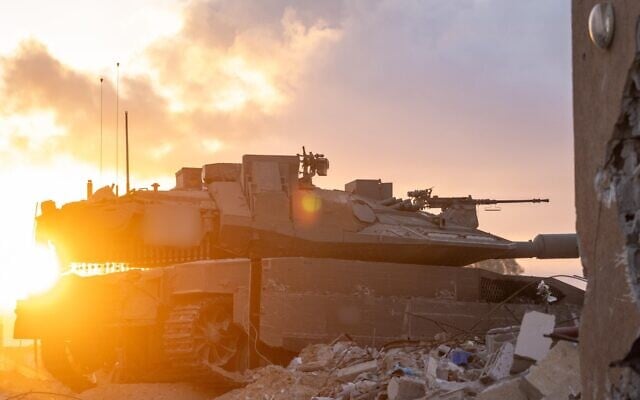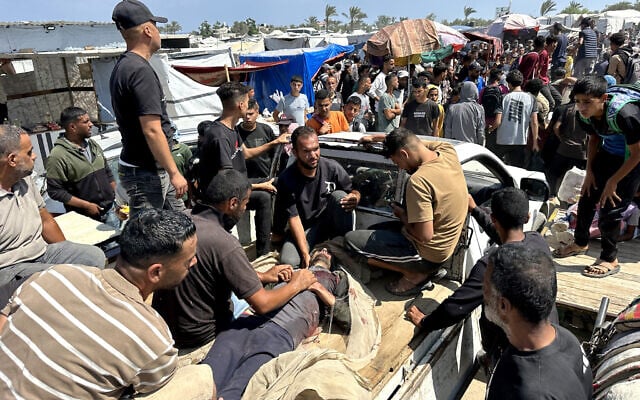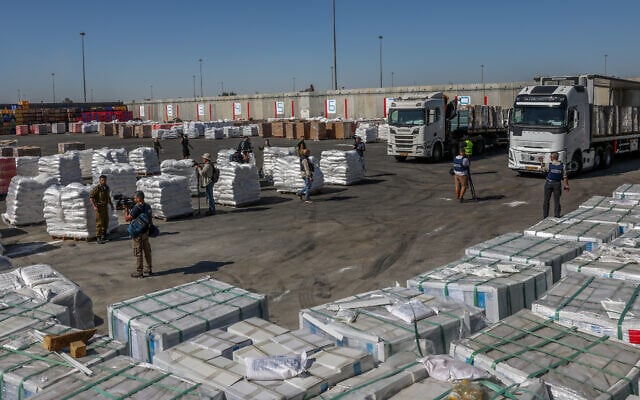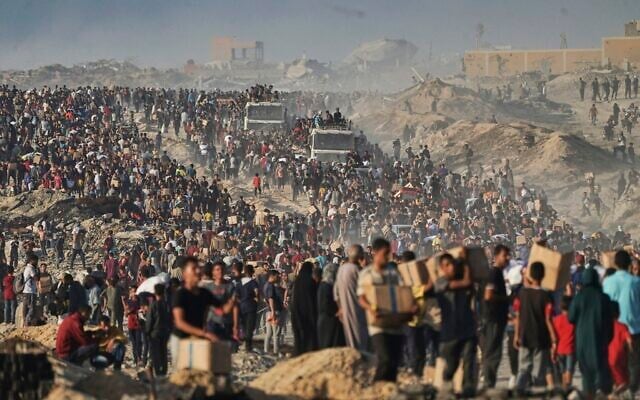


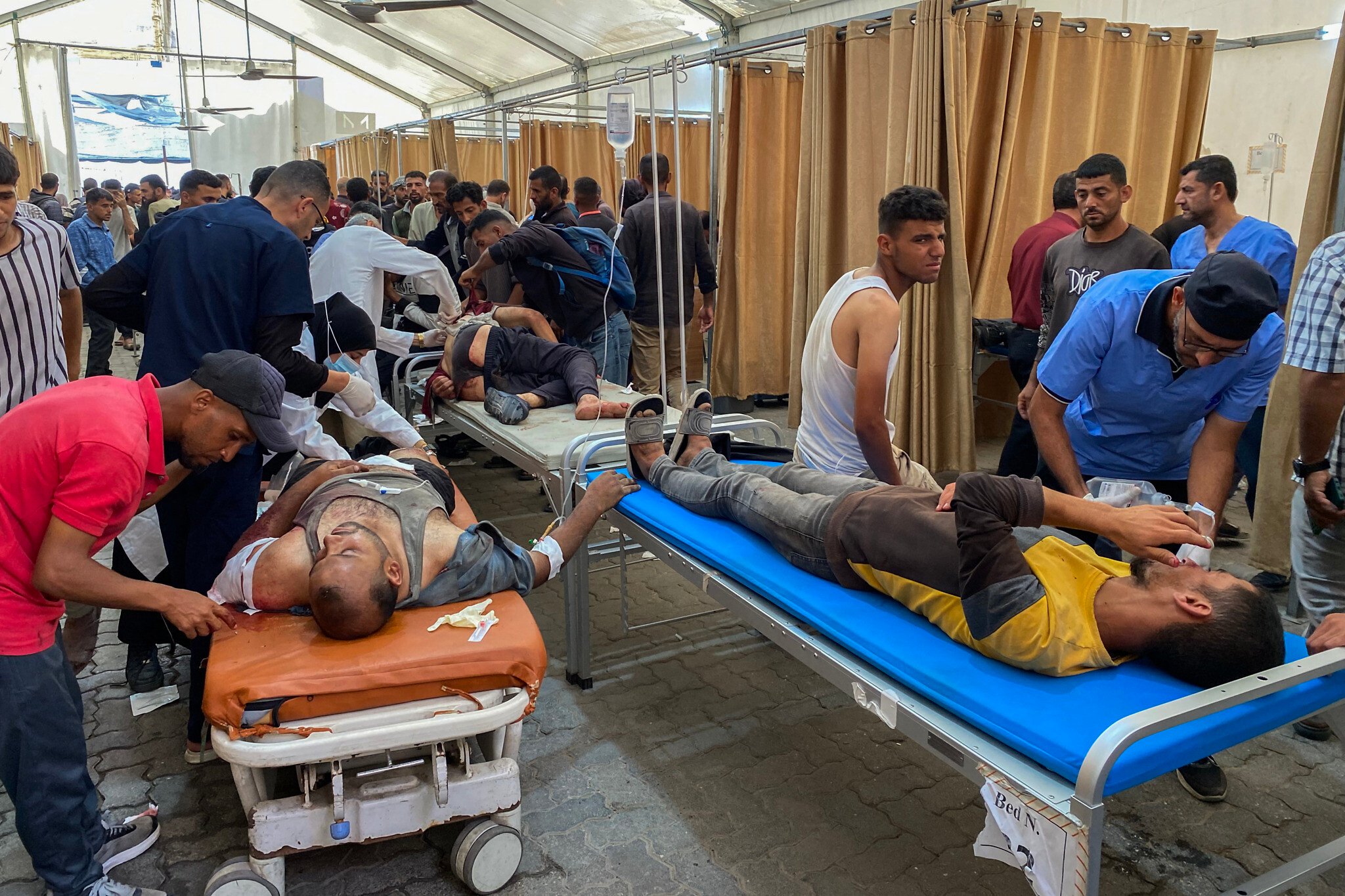
Nearly a month after deadly shootings were first reported around aid distribution sites in areas of Gaza under Israeli military control, mass casualty incidents are still occurring on an almost-daily basis.
The Gaza Humanitarian Foundation, which manages the aid sites, has consistently disavowed any responsibility for the reported deaths of hundreds of people trying to obtain the humanitarian assistance it distributes. The Israel Defense Forces, which is accused of carrying out the shootings, has acknowledged regret in some cases and says it is instituting changes aimed at making it easier for Gazans to reach the sites.
But while the IDF says it is looking into the incidents, they appear to have continued apace.
Between May 27 and June 24, there were at least 19 IDF shooting incidents related to humanitarian aid distribution, according to a review of reports out of Gaza conducted by The Times of Israel. These numbers have not been confirmed by Israeli authorities.
In many cases, the IDF has either declined to respond or stated it was unaware of the incidents. Many of the events were not documented with photographic evidence at the scene — only images of bodies and injured individuals arriving at hospitals in Gaza have surfaced.
On June 23, the Hamas-run health ministry in Gaza announced that 467 people have been killed while waiting for humanitarian aid since the GHF began operating on May 26. An additional 3,602 people were reported injured in these incidents. These figures have not been independently verified. The IDF declined to answer The Times of Israel’s question regarding how many such incidents it knew of.
According to reports from the Strip, the vast majority of these incidents occurred near GHF distribution centers — either in western Rafah in the south or in Deir al-Balah in central Gaza. One incident reportedly happened when a crowd gathered around a truck carrying humanitarian aid in Khan Younis.
Many of the wounded are brought to Nasser Hospital in Khan Younis.
“Every day (in the last month) we receive around 60 wounded and 20 dead from these incidents,” a doctor there told The Times of Israel via WhatsApp. “Most injuries are from live fire; some were hit by tank shelling.”
The Red Cross told The Times of Israel that between May 27 and June 19, approximately 1,874 casualties arrived at a field hospital it operates in Rafah, of whom 100 were declared dead.
According to the organization, about 90 percent of those treated came from mass-casualty events, and most reported being injured while trying to obtain aid at or near distribution centers in Rafah.
At a press briefing this week, Jonathan Whittall, head of office for the UN Office for the Coordination of Humanitarian Affairs in Gaza, alleged that the death toll may be even higher than reported.
“We are seeing a pattern of killing as Israeli forces open fire on crowds gathering to collect food,” said Whittall, who has met with some of the wounded. “Those who are shot are often beyond the reach of ambulances. We are told people are missing, presumed dead, inside these military-controlled areas.”
The GHF operates four distribution centers, all of which are located in zones that are under IDF security control far from where most civilians are living.
Three of the centers are located in western Rafah and one is in the Netzarim Corridor, near the Nuseirat and al-Bureij refugee camps in central Gaza. They do not operate simultaneously, with two or fewer typically open at any given time.
The GHF, which is backed by the US and Israel, was set up as an alternate mechanism to the UN-backed aid distribution efforts that have operated in the Strip for most of the war. According to Israel, the new system was needed due to assistance being siphoned off by Hamas, which sold the goods on the black market to fund its activities, including recruiting new fighters to rebuild its depleted forces. The claim has been denied by both the terror group and the UN.
After cutting off aid deliveries for over two months starting in early March, Israel has again begun allowing dozens of trucks of aid to enter the Strip daily. Some of the assistance goes to humanitarian groups backed by the UN, which continue to operate in populated areas, but much of it is earmarked for the GHF.
The United Nations, which had previously overseen most humanitarian aid distribution in Gaza, has opposed the new initiative, condemning what it described as a violation of the principle of independence for humanitarian actors. The UN further argued that the plan is inadequate and will not resolve the hunger crisis in Gaza, calling the model “a failure.”
In addition to the shooting incidents, numerous accounts received by The Times of Israel described a lack of organized distribution mechanisms at the centers, leading to chaos and looting.
According to the GHF, as of June 19, a total of 572,640 boxes of food had been distributed since operations began, which it says amounts to roughly 33 million meals. The food provided generally consists of dry goods that require cooking, despite a severe shortage of gas.
Johnnie Moore, who heads the GHF, said the organization was working to improve operations and reach as many Gazans as it could, but highlighted the complications of working in a war zone.
“It’s very important for people to understand that what happens within the distribution centers is one thing. This is an incredibly complex environment,” he told The Times of Israel. “It is definitely the case that Hamas has tried to do everything that they can to specifically target civilians, to disincentivize them from getting free food.”
“But it is an active war,” he added. “It’s dangerous to be anywhere in the Gaza Strip. It’s most dangerous to be in the domain of Hamas.”
Most of the reported shooting incidents have taken place in the early morning hours, when civilians make their way through IDF lines to the aid distribution sites. Videos from Gaza have shown large crowds gathering around the centers.
In at least some cases, the shootings appear to be the product of large crowds nearing Israeli military positions as they attempt to reach aid.
On June 3, the army said, it fired at individuals who strayed from an approved path as groups of Gazans moved toward a GHF site.
“The forces carried out warning fire, and after the suspects did not retreat, further fire was directed near individuals who continued approaching,” the army said after the incident. “The shooting occurred approximately 500 meters from the site and targeted individuals whose movement toward the forces posed a threat.”
According to reports, 24 people were killed in that incident.
A Palestinian involved in rescue operations told Jordan’s Al-Ghad news outlet that women and children were among the victims. “There were many dead and wounded at the site,” he said. “Most of the injuries were to the head.”
On June 17, the IDF responded to reports that its forces had opened fire on people seeking aid who had crowded around an aid truck in Kahn Younis.
“A crowd of Gazans was identified near a humanitarian aid truck that had become stuck in the Khan Younis area, close to IDF troops operating in the vicinity,” it said in a statement. “Reports of casualties from IDF fire due to the crowd’s approach are known. The details are under review. The IDF regrets any harm to uninvolved civilians and makes every effort to minimize such harm while maintaining the safety of its forces.”
According to Gazans, 59 people were killed, including from tank shells fires at the crowd.
“People took cans of food from the truck — because of the hunger. The trucks retreated due to the looting. They said more trucks would come. The crowd moved toward the red line. Within five minutes, a tank fired at us,” a Gazan civilian recounted to the Arab 48 website from Nasser hospital. “I hid… then pulled a man, a girl, and a woman — injured from the gunfire — onto my motorbike and brought them here (to the hospital) to get treatment.”
Another Gazan woman who was at the scene told Al Jazeera that the tank fire started almost immediately. “We didn’t even manage to grab the flour before the shells fell,” she said. “It’s indescribable. People’s limbs were severed. People died. People turned into corpses.”
Earlier this month the IDF issued a warning to Palestinians not to approach roads leading to GHF sites between 6 p.m. and 6 a.m., designating those areas as closed military zones. However, the GHF indicated that its centers could remain open during those hours.
A spokesperson for the GHF called the idea that the group was enabling massacres by opening during hours outside the IDF’s timeline “deeply misleading and offensive to the reality on the ground,” noting the desperation of the people the organization is trying to help.
“We do not want to open our sites in the middle of the night. We are forced to because thousands of desperate civilians – many of them women and children – are already gathering outside our gates,” the spokesperson said. “Gaza at present is not a controlled environment. It is a humanitarian emergency. People are starving, and their desperation is creating dangerous conditions that no amount of timing or process can fix.”
According to the spokesperson, who requested anonymity, UN aid trucks are also being “almost entirely looted by armed groups. The UN acknowledges that some looting is a problem, but denies that most aid is being stolen.
“The uncomfortable truth is this: until there is enough aid inside Gaza, there will be no such thing as ‘orderly’ delivery,” the spokesperson said. “If the UN and other humanitarian organizations would join us, we could scale aid across Gaza and there would be less need for beneficiaries to attempt to enter the sites hours earlier or take desperate and dangerous shortcuts.”
Asked about the numerous shootings, the IDF said it was working on improving procedures along routes to aid distribution sites.
“IDF forces are conducting systematic learning processes aimed at improving operational response and minimizing potential friction with the civilian population,” it said in a statement to The Times of Israel. “As part of this, IDF forces have recently worked to reorganize the area through the installation of new fencing, signage, the opening of additional access routes, and more. The reported allegations are known and are being examined by the relevant bodies as is standard.”
It also accused Hamas of “doing everything in its power to sabotage the food distribution effort in Gaza, disrupt humanitarian aid, directly harm the civilians of the Strip, and operate under civilian cover in an attempt to attack IDF forces.”
The army declined to respond to a question about whether it was using live fire as a method of directing crowds, as alleged by an officer quoted in an article in the Haaretz daily regarding a deadly shooting on June 1.
Moore said he believed crowding around the GHF sites would ease once the organization was able to ramp up its activities and get more assistance to more Gazans.
“As we’re able to scale the operation and move from two to four distribution sites per day, then some of that’s going to take care of itself naturally – especially when we can be more active in the north.”
“What you’re seeing at the beginning here is a reflection of food insecurity,” he added. “They need this stuff.”

